The Future Materials Library by Jim Biddulph
Kicking off the year’s long list of design trade shows, Heimtextil in Frankfurt; now in its 50th edition, is the first port of call for those looking for the very latest in home and commercial textiles. Some 63,000 visitors pass through the doors, eager to find out what the 2,952 international exhibitors have in store for them.
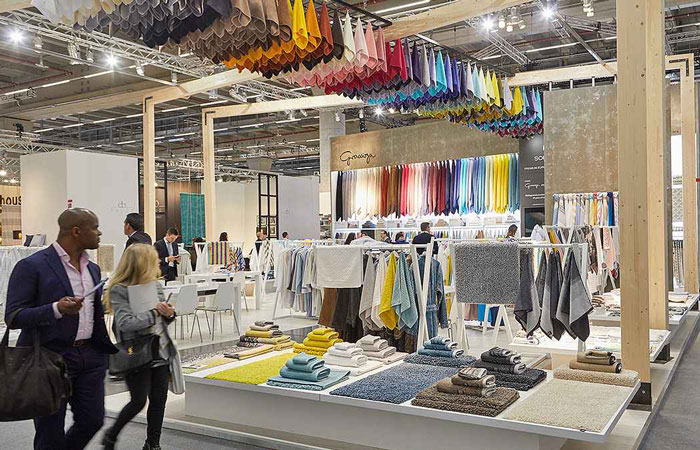
Each year, UK research agency FranklinTill curate a trend area that addresses the most relevant topics surrounding textiles and broader material developments. Building on the research and ideas covered in their fascinating book Radical Matter, this year they focus upon designer-makers who are taking an innovative approach to sustainable material sourcing and with it, forcing us all to rethink where our materials come from and where they will end up. I caught up with them to find out more about the Futures Material Library.
JB: At last year’s Heimtextil you curated the trend area with a theme titled Towards Utopia. What’s the story behind this year’s Futures Material Library?
FT: If you consider holistically where materials have come from, the processes and transformation you put them through, and where they will go after use, the social and environmental impact of our products can be totally redesigned. We wanted to explore and present the growing number of options at this year’s show.
JB: It’s a really exciting mix of materials, many of which are genuinely breaking ground, offering something new and mostly coming from young designers. Why do you think this is?
FT: We are potentially on the brink of a materials revolution that could help rebalance our relationship with our planet and reshape society for the better. Up to now, we have relied on a supply of natural raw materials that we transport to large factories and turn into products. We then ship those products around the world, where we enjoy them all too briefly and discard them when we no longer require them. This model is reaching its physical limits. We are running out of raw materials and creating enormous quantities of waste. We cannot continue to race through our planet’s finite resources; indeed, all the evidence suggests that if we continue at our current rate, we’ll soon need a second planet.
JB: That rings true with a lot of the environmental messages that were finally grabbing front-page news last year. Does that mean there is a little more hope on the horizon for 2020 and beyond?
FT: It’s become very clear that we need a better, smarter, more cyclical approach, in contrast to our current linear ‘take, make, discard’ relationship with materials – and a new future seems to be within our reach. Placing emphasis on materiality enables us to reconsider the building blocks of the design process from the bottom up. Thanks to a raft of exciting innovators and designers who are fostering disruptive approaches, we are beginning to see that alternative systems of production and consumption are possible – and we are recognising that material innovation will be crucial to achieving this.
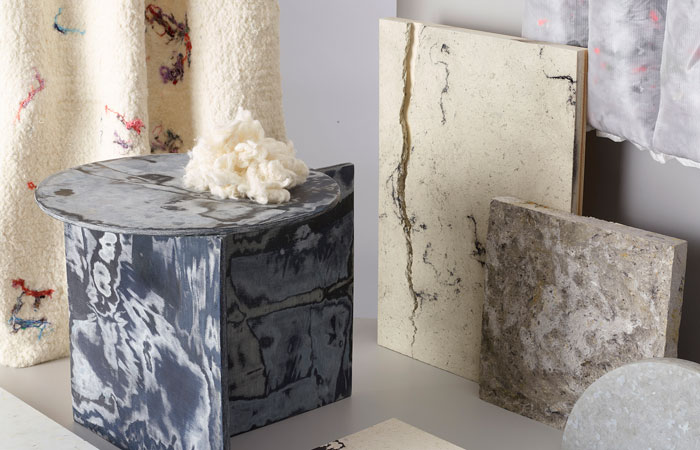
JB: You’ve created 4 sections for the show, each of which is made up of materials that share similar genealogy, approach to manufacturing or final application. Can you tell me a little more about them?
FT: With each section, we started with a simple question. In the case of Remade we asked, “Could today’s waste be tomorrow’s raw material?” What we found is that overconsumption of scarce natural resources is driving designers to rethink and reclaim waste materials in intelligent and sensitive ways. As well as offering environmental benefits, these innovations signal a shift in our relationship with materials and a reinterpretation of value. From single-use plastics repurposed by Smile Plastics to the textile offcuts and pre-loved clothing reworked by Eileen Fisher, designers are intercepting industrial and domestic waste streams before they reach landfill, and harvesting these alternative raw materials to create useful and desirable products.
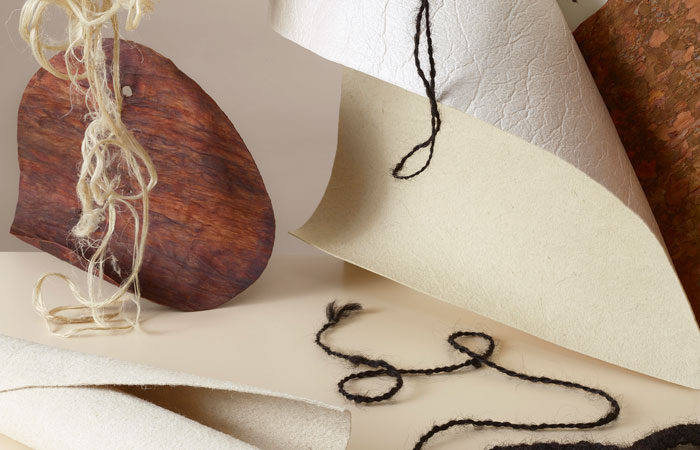
JB: The Biological By-products section asks even more specific questions of waste. What did you find by asking, “From food to faeces, could human and agricultural waste be explored as an abundant material resource?
FT: With the world’s population expected to exceed nine billion by 2050, should we be looking to the ever-abundant organic waste stream from humans as a way to replace contemporary polluting synthetics? From the by-products of agricultural industries to the clippings on hairdressers’ floors, experimental designers such as Pinatex and Fernando Laposse are re-evaluating organic waste matter to transform low-value or unwanted materials into products that are not only functional but also beautiful – and far removed from their origins.
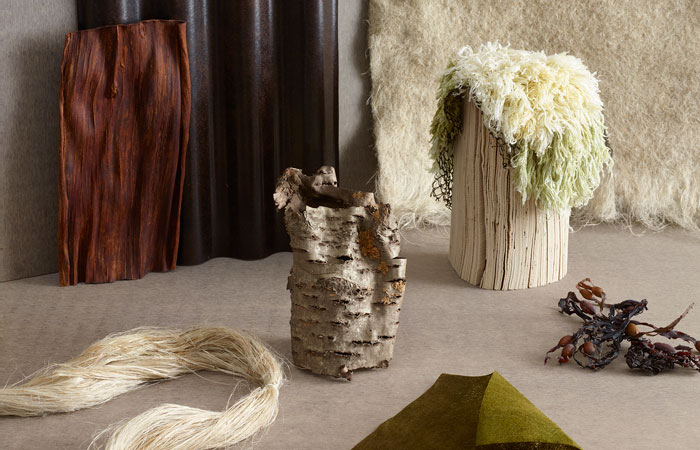
JB: Nature comes into play too and you throw down the gauntlet by questioning whether we can, “harvest naturally abundant materials in more agile and inventive ways?”
FT: Yes, the Natural Assets section is really interesting. Many of the natural materials on which we rely have been over-farmed and excessively cultivated for centuries, so resources that are abundant today may be scarce in the future. To harvest sustainably, we need to be flexible and inventive, basing our manufacturing on what is currently and locally available. The mainstream textile industry has traditionally drawn heavily on natural resources, with catastrophic consequences in terms of pollution and overexploitation. Now, naturally resilient varieties and widely forgotten heritage fibres are coming to the fore as viable, sustainable alternatives. Natural Assets shows a series of projects that span both high-tech innovations such as Bananatex and traditional techniques such as hand-felted Jute by Alexander Marinus, to unlock the hidden qualities of some of the world’s most abundant and bio-positive plant life.
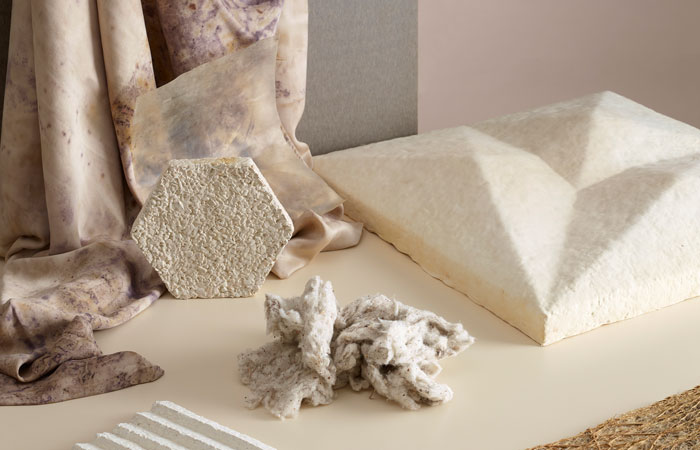
JB: Further inspiration is drawn from nature in the Living Materials section and again, the question you ask is very clear and direct – “What if materials could be grown, rather than made?”
FT: Inspired by the closed-loop, circular systems found in the natural world, designers and material innovators are using fungi and bacteria to produce biodegradable materials such as mycelium, lab-grown vegan leathers and textile dyes – working with nature rather than against it. Imagine a world where designers use algae as a sustainable fabric for furnishings; where textiles are dyed using harmless bacteria, rather than toxic chemicals, as explored in the work of Faber Futures; and where cruelty-free leather alternatives such as those by Malai are artificially produced without the use of plastic-based materials.
Remade featuring:
Charlotte Cazals, Reaburn, Paperfactor, Sophie Rowley, Smile Plastics
Biological By-products featuring:
Studio Sarmite, Pinatex, Sanne Visser, Fernando Laposse
Natural Assets featuring:
Margent Farm, Hey Jute, Nienke Hoogvliet, Barktex, Studio Tjeerd Veenhoven
Living Materials featuring:
Faber Futures, Malai, Mogu, Ty Syml, Diana Scherer




